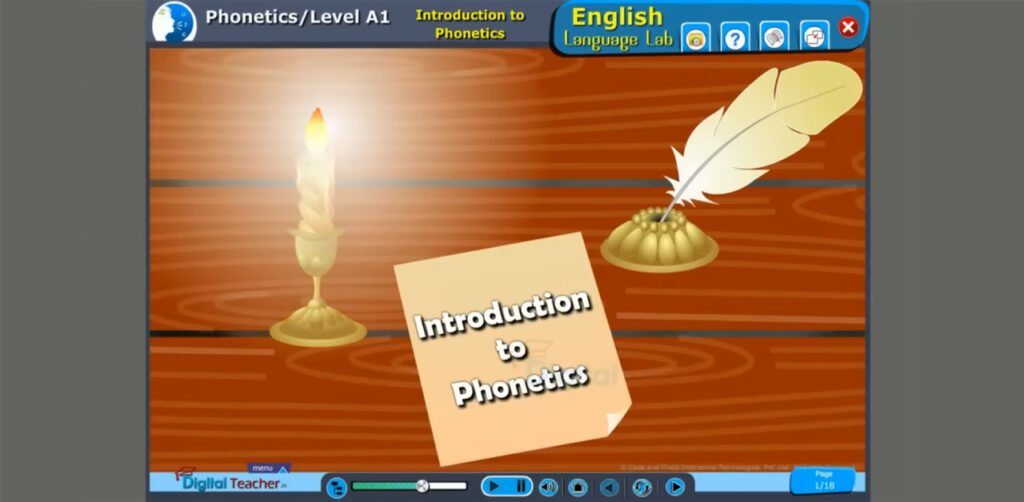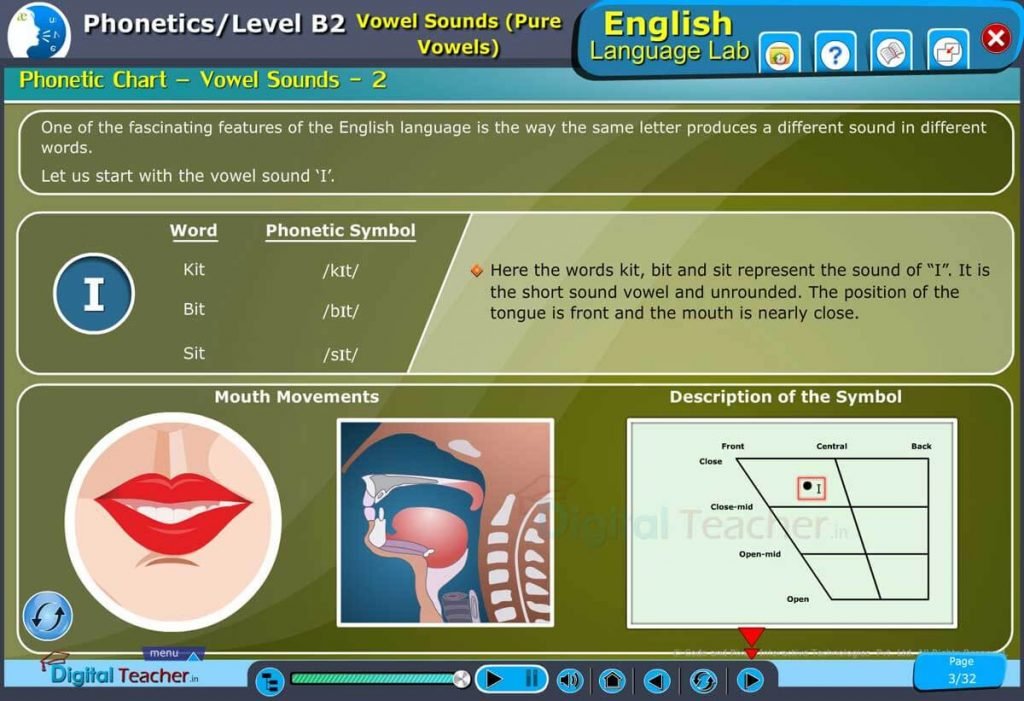Phonetic Sounds and Syllables With English Language Lab Software
Description
Detailed Exploration of Phonetic Sounds and Syllables
While learning the English language, our Digital Teacher English Language Lab Software (DT-DELL) offers a comprehensive review of phonetic sounds and syllables. It provides examples and explanations for every phonetic level, including simple monosyllabic words and complex multisyllabic situations.
In our Language Lab Software, we explain how computing resources and phonetic tables may help with the knowledge of vowels, diphthongs, and consonants. Practical exercises like sound identification and examples of how American and British English are spoken differently are also included.
It also covers English voice modulation, stressing pitch, tempo, and a focus for clear communication. The sessions discuss overcoming the impact of Mother Tongue Influence (MTI) and explaining difficult syllabic words.
 Introduction to Phonetics by English Language Lab Software -Digital Teacher
Introduction to Phonetics by English Language Lab Software -Digital Teacher
A Complete Guide to Phonetics with English Language Lab
Phonetics is essential for learning any language, especially English, which has challenging pronunciation rules and lots of spoken words. The Digital Teacher English Language Lab software provides a focused and engaging way to learn phonetics, syllables, and sounds. The following guide will bring you through the important components of the phonetics part, focusing on how the software helps learners at all levels (A1 to C2) develop these fundamental skills.
Let’s start with an introduction to phonetics. This will offer a solid grasp of how phonetics works and why it is so important for improving English pronunciation.

Phonetics: An Introduction?
Phonetics is the study of sounds used in human speech. It explains how sounds are created, changed, and noticed. Phonetics in English helps students understand how to pronounce letters and words correctly, which is essential for effective conversation.
The phonetics component of the Digital Teacher English Language Lab started with an Introduction to Phonetics. This section gives an overview of the English alphabet, which consists of 26 letters. The software allows students to click on each letter to hear the right pronunciation, which helps them become acquainted with the fundamental building blocks of English phonetics. For example, by clicking on the letter ‘Q,’ users may hear its distinct sound, which helps with the proper pronunciation of words beginning with ‘Q.’
Following this, we’ll look at the Phonetic Table and Sounds, which will break down the various phonetic symbols and the sounds they represent. Keep reading for a more in-depth look at how these components play a part in proper pronunciation.
 Phonetics Lab – Digital Language Lab
Phonetics Lab – Digital Language LabPhonetic Table: (Alphabet vs Phonetic Sounds)
The Phonetic Table is an essential component of the Digital Teacher English Language Lab, providing a detailed examination of the different sounds in English. The table separates these sounds into vowels, syllables and consonants, providing students with an engaging way to hear and practice pronunciation. Below is a simplified example of what the Phonetic Table includes.
| Sound Category | Examples | Symbols | Example Words |
|---|---|---|---|
| Vowels | Short and long vowel sounds | /æ/, /i:/ | “cat,” “sheep,” “pot,” “moon” |
| Diphthongs | Combination of two vowel sounds | /ai/, /ei/ | “rain,” “face,” “coin,” “house” |
| Consonants | Voiced and voiceless consonants | /k/, /g/, /ʃ/ | “kite,” “game,” “ship,” “measure” |
Phonetic Table and syllables: English Language Lab
After reading the Phonetic Table and Sounds, I’ll explain how to use it successfully in practice. To see the Phonetic Table and syllables, see the GIF below, which shows these elements as they appear in the Digital Teacher – English Language Laboratory Software.
 Gif: Alphabet vs Phonetic Sounds in English Language Lab Software
Gif: Alphabet vs Phonetic Sounds in English Language Lab SoftwareHow to Use the Above (Phonetics) Table: in English Language Lab Software
- Click on Symbols: To hear a phonetic sound, learners can click on each symbol.
- Practice with Words: Each sound is explained by sample words that show how it is used in context.
- Compare Sounds: This software enables side-by-side comparisons of comparable sounds to help in differentiation.
If you want to help students in your classroom learn English phonetics effectively go to https://www.englishlab.co.in/phonetics right now. You may also schedule a free demo by calling us at 90000 90702 
Youtube video






You must log in or register a new account in order to contact the publisher
Useful information
- Avoid scams by acting locally or paying with PayPal
- Never pay with Western Union, Moneygram or other anonymous payment services
- Don't buy or sell outside of your country. Don't accept cashier cheques from outside your country
- This site is never involved in any transaction, and does not handle payments, shipping, guarantee transactions, provide escrow services, or offer "buyer protection" or "seller certification"






